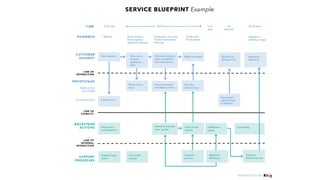Experience maps method
- 2. Besides Experience Maps, different names are used to referto similar representations, although there are some nuances in the lattertwo, is betterto include them in the group ofthe multidimensional maps. Customer Journey, User Journey and some time Blueprint or Service Ecology
- 3. Starbucks experience map: https://www.dropbox.com/s/4xyysqmylfpvemw/Starbuck s_experiencemap1.pdf?dl=0 The differences and similarities between them can be summarized in this aspects: 1. Content common across most of Experience Map are: -User needs /experience triggers. -Experience phases. -Mental status (E.g. Attitude, Motivation, Mood, etc.) -User emotions, thoughts, feelings and reactions during experience. -Touchpoints: user interaction points; pain points; delight points. -System actions (interaction from system point ofview) -Persona and Scenario resume. -System opportunities and service barriers. -The path (journey sequence)
- 4. 2. Layout: Could be Timeline, where touchpoints are located over a path timeline organized and. Wheel, used mainlyfor reflecting a product or service overall experience.
- 7. A simple Experience Map only reflects one possible path during one scenario.
- 8. Acomplex Experience Map could encompass cross platform, experiences occurring at di?erent time sessions/scenarios
- 9. The right layout foryour Experience Map will depend mainly on: The amount and richness ofthe content. As number oftouchpoints of opportunities, interaction types, devices involved, etc. And in what aspects do you want to put more emphasis: In the touchpoints? The system interaction features/functions? Emotional factors ofthe experience? etc. How to choose one layout? https://uxpressia.com
- 10. Some tips before starting… ?Have your user in mind all the time ?Howwill this persona react to this? What would she do? Howwould she feel? ?A userJourney is compoud of user stories and user stories are broken into tasks forthe benefit of developers. DIY Experience Map LET’S BEGIN!
- 11. Web app? Responsive website? Mobile app? System to be modelling 01
- 12. You need one persona belonging to your product target. Persona 02
- 13. One goal that will direct user behaviour during experience flow. Basically: what is the persona’s purpose forthis specific interaction in this particular scenario? What is he trying to accomplish?. Goal 03
- 14. You will need to define an initial Mental State as a starting point foryour persona. This mental status will suffervariations during the experience and you should reflect these changes in the key phases of interaction. Mental Status 04
- 15. User Stories: https://www.dropbox.com/s/icj4ir52459r131/EG_User_S tory.pdf?dl=0 How to make a User Story? ?User Role—As a user, I can… ?User Story—I want to… ?Value—So I can… ?Conditions of Satisfaction —Verifythat… ? Notes—Details from discussions ? Priority ?Level of Effort 1 or more User Stories break into tasks 05
- 16. And...a task?Just simple actions but have to be Specific, Measurable, Achievable, Time Boxed E.G. 1. Select option to create a new course 2. Select source of course content 3. Modifyproperties 4. Modifycompletion criteria Tasks: https://www.dropbox.com/s/5lpzjljcelo2qct/User%20stories.pdf?dl=0
- 17. The scenario must respond to: What is the singular situation? describe the stories behind why a specific user or user group comes to your site. Scenario 06
- 18. Such as physical environment, device and platform constraints, physical space and device or platform in which the experience is taking place. Context 07

















